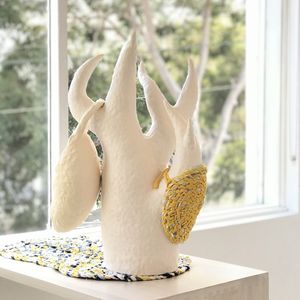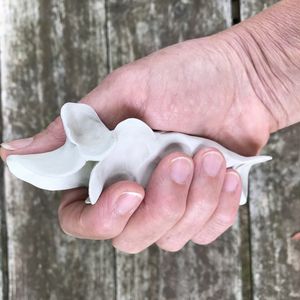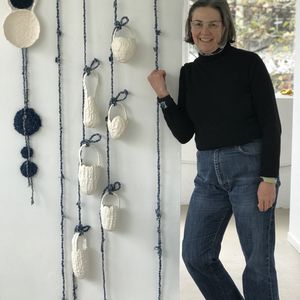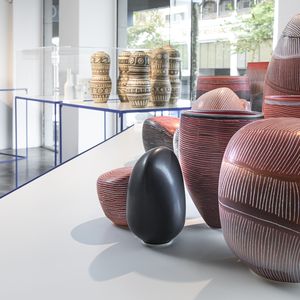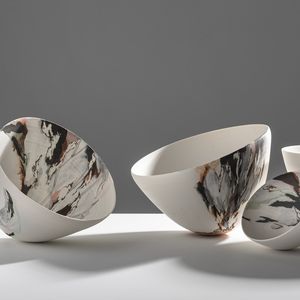Series 2 Episode 4: Writing about ceramics with Robyn Phelan
Clay Connections
/https://adc-2-prod.s3.amazonaws.com/media/dd/images/Robyn_Phelan_portrait.d090f9c.jpg)
Series 2: Clay Connections
Episode 4: Writing about ceramics with Robyn Phelan
Show notes
Meet ceramic artist and writer Robyn Phelan and hear:
- What makes a good piece of writing about visual art?
- How she approached writing about a Damon Moon exhibition
- How can we get critique back into Australian arts commentary?
- How to use writing in your arts practice, and
- Tips for new arts writers.
And, hear fine art photographer Greg Piper on
- What makes a good photograph of ceramics?
- How to get the narrative of your work across through a photo, and
- Why you should have your work professionally photographed.
Transcript
Word document: Writing about ceramics with Robyn Phelan S2 Ep 4 TRANSCRIPT
PDF document: Writing about ceramics with Robyn Phelan S2 Ep 4 TRANSCRIPT PDF
Guests
Robyn Phelan is a writer, a ceramics artist and an educator. She writes regularly for The Australian Journal of Ceramics, and her other writing includes exhibition text and catalogues, reviews and articles.
Greg Piper is a fine art photographer and "passionate image maker to the arts community". His work includes artist portraits, exhibitions and publications.
Show highlights and takeaways
[2:12] “The first time I put my hands on a Patsy Hely”
Robyn’s career in the arts started with a degree in arts and crafts, secondary teaching. She later studied curation and worked in registration at the National Gallery of Victoria. At the NGV, she encountered the work of ceramics artist Patsy Hely - “tiny versions of 1960s saucepans, with the anodised coloured lids and the little bakelite lid,” together with porcelain vessels that fitted these pots.
Robyn thought, “Wow, it's thrown beautiful ceramics, but it's contemporary using found objects.”
[4:30] Writing for the local newspaper
Robyn began her career in arts writing by reviewing exhibitions for Melbourne’s Northwest Neighbourhood News.
“I didn't feel I could pitch to a contemporary journal. I just didn't know how to do that. I just would write about the exhibitions in the local newspaper and they were happy to take the content. I did that for a couple of years and that really honed my skills.”
[5:00] Writing her own blog
Robyn also started blogging about exhibitions and continues to publish writing there. The name of her blog is Looking With Soft Eyes, a statement that comes from the TV series The Wire.
She chose this title because the detective in the series advises, “Don't go in hard and try and find the evidence. Go in softly and see what comes to you.”
And that's how Robyn says you should see an exhibition.
[5:30] Victorian Report for The Journal of Australian Ceramics
For ten years, Robyn also reported on ceramics artists and exhibitions in Victoria in a regular column for The Journal of Australian Ceramics. She said it was great practice in getting “to the nub of it in 200 - 300 words.”
[6:35] What makes a good piece of writing about visual art?
You have to be in the exhibition, or you have to have been with the work.
“I love that sense of, you know, embodying the work, embodying the work in space, and experiencing the work as is presented either by a curator or by an artist in a space because you need to be able to see the surfaces.”
The opening lines of your writing might be about what you see and what you feel. She says that hook can break down the distance between the reader and the writer: “I went here, I saw this, I felt this, I observed this with my eyes.”
And then the rest (and this is the hardest thing, she says) is to have something to say that's interesting.
[7:30] Writing about Damon Moon’s exhibition in Bendigo and Shepparton, Victoria
Damon Moon had a series of exhibitions based on his skittle form based on a vase shape by William State Murray, who is a British designer. Robyn says that his skittle object can carry any glaze or any manipulation, and “it tells this other story, which is what I loved about it.”
One thing Robyn wrote about was about the materiality of one of the terracotta forms, that had some punctuations. She imagined him pulling it out of the plaster mould, this terracotta, chocolatey-coloured, soft, leather, hard thing and just poking his fingers around and thinking, “I bet Damon is a little boy at Easter, and got that bunny form and just crack. Did a real crunch onto the ear or maybe he was with that kid that broke it down. I was just wondering, you know, what did he do with his Easter eggs at Easter?”
[9:30] What makes a good photograph of ceramic artwork?
Professional art photographer Greg Piper says that while what makes a ‘good photograph’ is very subjective, his usual go-to is the selection of appropriate mood, based around intensity and shadow.
“Photography is not just adding light, it's adding shadows. Because shadows influence how an artwork appears.”
[10:00] Trends in ceramics photography
He says that certain countries have certain styles of ceramics photography: “The Japanese might have dark space and little kisses of light enveloping an artwork, in a dimly lit mood.”
Greg says one current trend is for white on white images, which he calls “bland shadowless”. The artwork appears as a two-dimensional object and doesn't really reveal that it's got depth and roundness.
He observes that sometimes the photographer and the artist don’t have a choice in how the work is photographed, with the style being dictated by a gallery or a magazine.
[10:50] What’s the narrative of your ceramic work?
Greg asks artists about the narrative behind their work, and how that narrative can be communicated through a photograph? It can be a useful thing for the artist to think about before employing a photographer.
[11:35] What features of your artwork do you want to bring out in a photograph?
These features might include
- the textures - rough or smooth? Graffito, decal or other elements, and
- the shape of the form
- details
Then a photographer will find the appropriate lighting, and setting.
“In the majority of cases it's important to be true to the artwork you produce and bring out the features that you have put into it.”
[12:00] “Create a moment where the viewer will stop”
People have become skimmers, Greg says, because they’re mostly viewing images on their phone. The goal and the challenge is trying to make the viewer stop.
[12:30] Primary, secondary and tertiary viewpoint
Greg says he’ll often ask an artist, “Where's your primary viewpoint? You have looked at this piece for days, weeks, months. You must find that it sits in your gaze at a particular view.”
How do you imagine the audience will look at your work? Looking down, or from the side, or rotating? Photographers often say, Which are the primary, secondary, and tertiary viewpoints?
[13:00] Learning to seeing your own work
Greg emphasises that all these things, in the process of working with a professional photographer, help develop you as an artist, and your way of seeing your own work.
[14:15] Using wall text in an exhibition
For Robyn’s recent exhibition, she wrote for the gallery walls.
Baskets hold. Gather and store the utility is enriched by their ease and fit to the human body as they assist in the labor of carrying skilled hands are required to carry or craft a basket form often with make-do materials.
“So what you were looking at when you read that text was a whole lot of heavily textured ceramic vases, really with big handles on them, suspended from the roof by twine made by my denim jeans. So you were looking at ceramic forms, but I'm telling you it's a basket. The language and the words add to the visual of the artwork.
And that's what I wanted people to hear, and to think about weaving as a surface, not just a ceramic surface. So that's that kind of idea of the supplemental information that adds to what you're actually looking at.
And the exhibition was called The Wait of Waiting and it combined works that I made during lockdown and pre lockdown. Playing with this idea of gravity and heaviness of that waiting time and also the weight of, of clay suspended using textiles that I plied from shredded denim jeans that my neighbourhood gave me during lockdown.
So the wall text is really important to me, but it can't be too long.”
[15:40] Words can be visual too
Robyn argues that Ideas and words are visual as well, saying we can fall into the trap of being too text-heavy. She points to blockbuster art shows where everyone's piling up at the threshold, reading this great big text blocks about the show.
She says you can have very subtle key words, spatially arranged and they can add to a deeper understanding of the work or prompt ideas that are really important to the maker.
These key words can expand the work or give an insight on what the artist would like people to know.
[16:30] Field Notes in her journal - using writing in her arts practice
Robyn writes as she makes, similar to Field Notes from anthropology. She doesn’t write about the technical process but about how she’s feeling, what she’s doing, what and what she’s observed.
“How I'm feeling as a person in the space at this time that I've chosen to make.”
Robyn says habitually writing Field Notes in her journal also comes from being a mother and not having a studio.
“The journal is very important to me. I started studying when I had a six month old, so it's always the last thing on the list and sometimes you don't get to the studio.
But the journal's always there.”
[17:55] Tips on writing an artist statement
Robyn teaches her students how to write an artist statement. Her key tips are:
- Get it down to a couple of sentences
- The first part is you as an artist - why you make art, why you feel creative and what you like to do
- The second part is What is this work about? What is this particular project?
[18:40] Instagram as a diary
Robyn uses her Instagram account to “tell a story of what I'm making or thinking about as far as my practices are concerned. I say to myself, I'll only post once a week twice if that.”
[19:50] Photography to make an archive of your work
Greg Piper says the other reason to have your work photographed is to archive your work for use in exhibition invites and promotions.
He gives artists three folders of images - TIFFs, high resolution JPGs and SRGB folder, scaled and set up for Instagram and Facebook straight away. This means you can act quickly with requests for images. Greg says that while you can take photos with your mobile phone, some phones can’t take the resolution and quality that’s sometimes required.
Greg also points out that once your artwork is sold or given to someone, there's no evidence that it existed - another reason why he feels an artist needs to have their work photographed.
[21:50] “We don’t have a critical review culture in Australia” for ceramics
Robyn says that probably the last person that critically reviewed ceramics was Robert Nelson in Melbourne, and that would be the nineties.
“There's so little critique around contemporary ceramic practice, and contemporary arts, I see it as a waste of time to be overly negative and critical if there's so little writing.
Make it optimistic and, impassioned and spread the good news stories.”
Robyn reflects that perhaps critique isn't about critical critique.
“Maybe a critique will happen in The JAC [Journal of Ceramics] in the future around issues and concepts. So it's not pointing at a particular person's work output or work outcome, which we want to celebrate, cause it's so hard to get an exhibition together and up.
Maybe the critique is around something that's a burning issue and that's how we bring people in to debate things.”
[24:50] Top tips for new arts writers
Be warm and really engaging
When you write about the work, show that you love it and you are, do love it because you are writing about it.
Understand the history of the technique
We stand on the shoulders of a long tradition of clay and ceramics so, always call that to attention. And if you don't know as a new writer, ask. There's plenty of established ceramic artists who say, in this pot here, does that look like, oh, who does work does this look like? What part of cultural history or what Australian ceramic history does that belong to? Acknowledge the legacy.
Enjoy and savour writing
Enjoy and savour writing about what you see in front of you and what you love about it. The glaze quality, the volumes and the scales of the work and how it makes you feel and how you want to peer into it because it's a three-dimensional object and that's the joy of it.
Do the work
Spend your time, do the work. Do some research, brainstorm some ideas and words. You really just gotta get the words down and spend the time and it will come to you.
CREDITS
Object is a podcast of the Australian Design Centre. We'd like to thank Visions of Australia, the Federal government’s regional exhibition touring program for funding support towards this podcast.
Object is produced by Jane Curtis, in collaboration with Lisa Cahill and Alix Fiveash. Sound Engineering is by John Jacobs.
Return to Object: stories of design and craft main page.

